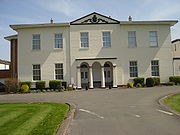
Robert Marsham
Encyclopedia

Phenology
Phenology is the study of periodic plant and animal life cycle events and how these are influenced by seasonal and interannual variations in climate...
, the study of the effects of the seasons on plants and animals.
He was born in 1708 and admitted to Clare College, Cambridge in 1728. From a very early age he had shown a passion for the natural world. In later life, he owned a modest sized country estate in Stratton Strawless
Stratton Strawless
Stratton Strawless is a village in the county of Norfolk and district of Broadland. The civil parish covers and has a population of 495. Located close and to the east of the A140 road and being south of the market town of Aylsham and some north of Norwich...
, Norfolk
Norfolk
Norfolk is a low-lying county in the East of England. It has borders with Lincolnshire to the west, Cambridgeshire to the west and southwest and Suffolk to the south. Its northern and eastern boundaries are the North Sea coast and to the north-west the county is bordered by The Wash. The county...
and became friendly with the naturalist Gilbert White
Gilbert White
Gilbert White FRS was a pioneering English naturalist and ornithologist.-Life:White was born in his grandfather's vicarage at Selborne in Hampshire. He was educated at the Holy Ghost School and by a private tutor in Basingstoke before going to Oriel College, Oxford...
, with whom he carried on a lengthy correspondence and who described him as a 'painful and accurate naturalist' (by "painful" he would have meant "painstaking").
He is best known for his Indications of Spring, the phenology notes in which he recorded 27 signs of spring, starting in 1736 and continuing for over 60 years. Successive generations of his family added to his work until well into the 20th century and this information now provides immensely valuable data to the UK phenology database, giving us a wealth of knowledge about how spring is influenced by prevailing weather conditions, This is now of huge interest in the climate change
Climate change
Climate change is a significant and lasting change in the statistical distribution of weather patterns over periods ranging from decades to millions of years. It may be a change in average weather conditions or the distribution of events around that average...
debate. Marsham was the first to record the effects of nature and seasonal change.
Marsham provided a fascinating insight into the winter of 1739/40, the coldest year on record, when the contents of his chamber pot
Chamber pot
A chamber pot is a bowl-shaped container with a handle, and often a lid, kept in the bedroom under a bed or in the cabinet of a nightstand and...
frequently froze overnight and the turnip crop was completely destroyed. Turnips, being a Norfolk speciality, feature elsewhere: he regularly recorded turnip flowering dates (needed when turnips were to produce seed). On a lighter note he was amazed at the size a turnip achieved and he was obviously very proud.
Marsham is still the only person in Norfolk
Norfolk
Norfolk is a low-lying county in the East of England. It has borders with Lincolnshire to the west, Cambridgeshire to the west and southwest and Suffolk to the south. Its northern and eastern boundaries are the North Sea coast and to the north-west the county is bordered by The Wash. The county...
to have recorded the wallcreeper
Wallcreeper
The Wallcreeper is a small passerine bird found throughout the high mountains of Eurasia. It is the only member of the genus Tichodroma.-Taxonomy and etymology:...
bird.
His interest in trees resulted in his being elected a Fellow of the Royal Society in 1780. His Indications of Spring were published in 'Philosophical Transactions' by the Royal Society in 1789.
He married twice: firstly Mary Browne of Yaxham, who died in 1752, with who he had one son, Robert (1749–1812); secondly Elizabeth Newby of Stratton (1739–1807), with who he had another son, Thomas (1758–1773)
The Great Cedar


Atlas Cedar
Cedrus atlantica, the Atlas Cedar, is a cedar native to the Atlas Mountains of Algeria and Morocco . A majority of the modern sources treat it as a distinct species Cedrus atlantica, but some sources consider it a subspecies of Lebanon Cedar Cedrus atlantica, the Atlas Cedar, is a cedar native to...
, known as the Great Cedar, which he planted in 1747 as an 18 inch sapling. The tree is located in Reed-house grove to the east of the Stratton Strawless hall; it was last measured in 2000, at which time it had attained a height of 102 feet and a circumference of 23 feet.

